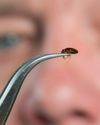
When we think about living things and where we find them, we tend to think at large scale. The word that comes to mind is 'habitat', which conjures up images of forests, deserts, oceans, swamps and the many other diverse places on Earth where life can be found.
Of course, we might also be thinking at a smaller scale, focusing perhaps on our garden, a local hedgerow or a small pond. If you think at the right scale, though, pretty much any physical space can be habitat to something.
Anyone who has looked closely at mites living on a leaf, or at tiny springtails under the decaying bark of a dead tree, will have marvelled at the wonder of microhabitats. But when you start thinking at a really small scale, when a microscope is needed to see what's going on, then habitat can become very interesting indeed because once you think small enough, there's no better habitat than that offered by other organisms.
Living in or on other organisms offers many advantages if you can pull it off. Your host may not be entirely amenable to you taking up residence, but they can provide you with all the shelter, resources and travel you might require.
You may even provide your host with some advantages in return: many of the bacteria that live within our guts, for example, help us with aspects of digestion. Such mutually beneficial relationships are known as mutualisms and are quite common.
هذه القصة مأخوذة من طبعة Issue 73 من Very Interesting.
ابدأ النسخة التجريبية المجانية من Magzter GOLD لمدة 7 أيام للوصول إلى آلاف القصص المتميزة المنسقة وأكثر من 9,000 مجلة وصحيفة.
بالفعل مشترك ? تسجيل الدخول
هذه القصة مأخوذة من طبعة Issue 73 من Very Interesting.
ابدأ النسخة التجريبية المجانية من Magzter GOLD لمدة 7 أيام للوصول إلى آلاف القصص المتميزة المنسقة وأكثر من 9,000 مجلة وصحيفة.
بالفعل مشترك? تسجيل الدخول

TAKE IT SLOW
Slow running is a fitness trend with some hard and fast science behind it

Physics, AI and music share a common thread. You just have to know where to look
Studying science can lead you in many directions and open doors to unexpected possibilities along the way

BED BUGS VS THE WORLD
When bloodthirsty bed bugs made headlines for infesting Paris Fashion Week in 2023, it shone a spotlight on a problem that's been making experts itch for decades: the arms race going on between bed bugs and humans

Kids are the key to understanding obesity. But we need more of their genes...
We can unravel the role that bodyweight plays in disease, but we need a bigger, more diverse, sample of genetic material to do so

COVID inquiry: What did we learn and what can we do better in future pandemics?
Masks, social distancing, lockdowns... how effective was the UK's response to the COVID-19 pandemic?

One hormone could be the key that unlocks a cure for morning sickness
The nausea and vomiting that, in extreme cases, can endanger mothers and babies might soon be just a memory

THE WORLD'S WEIRDEST CREATURES
Under the sea and upon the land, some animals look - to us - pretty strange...

WHEN MIND AND MACHINE COLLIDE
First, Elon Musk wanted to make electric cars ubiquitous, then he wanted to make space exploration a private enterprise. Now, with Neuralink, his newest venture, Musk hopes to merge humans and artificial intelligence. Turns out, it might not be such a crazy idea...

COME OUT OF YOUR SHELL
Social anxiety is more than just being shy. It's a phobia born out of our evolutionary past. But that raises a puzzling question: why do so many of us fear human interaction when we're supposed to be the most sociable species on the planet?

SPACE ODDITIES
Take a tour of the weirdest spots in the universe, where the 'normal' rules don't apply. Places that squeeze time, blow bubbles and even rain glass... sideways